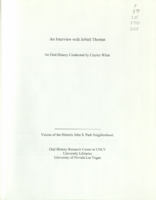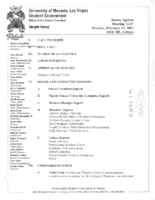Search the Special Collections and Archives Portal
Search Results

Interview with Bruce Walter Church, April 27, 2004
Date
Archival Collection
Description
Access note: May not quote in any form without written permission from interviewee
Text

Transcript of interview with Jim Bilbray by Jeff van Ee, March 26, 2009
Date
Archival Collection
Description
Jim Bilbray served Nevada as member of the Board of Regents of the University of Nevada, chief legal counsel in the Clark County Juvenile Court, Nevada State Senator, member of the United States House of Representatives, the United States Senate, and is currently on the Board of Governors of the US Postal Service through 2015. Jim was born in Las Vegas on May 19, 1938. Among his most memorable accomplishments is his work for the environment. As a young boy growing up in Las Vegas, he loved the climate. His backyard at the family home on 3rd Street was at the edge of the city so his playground was the desert. These early years led to a lifelong appreciation for the Nevada outdoors. The 1980s and 1990s were historical for Nevada and environmental efforts. The Nevada environmental triumvirate and congressional delegation composed of Jim, Harry Reid and Richard Bryan are widely known for passing significant legislation in this field. They worked closely together, in part, because of their friendship formed while growing up together in Las Vegas. This interview helps put into perspective the pivotal role played by Congressman Bilbray. During his terms as Nevada Senator (1981 - 1987) and US Representative (1987-1995), Jim worked on a number of major public lands issues for Nevada. He helped to defuse the Sagebrush Rebellion, designate additional Forest Service wilderness, protect Red Rock as a National Conservation Area, assign the Spring Mountains as a National Recreation Area, and initiate the legislative effort to establish the Southern Nevada Public Lands Act. Jim currently resides in Las Vegas where an elementary school is named in his honor.
Text

Transcript of interview with Thomas Rodriguez by Maribel Estrada Calderón, September 10, 2018
Date
Archival Collection
Description
Known for “raising hell and making a difference” in the Las Vegas Valley, Thomas Rodriguez has dedicated more than four decades of his life to the political, educational, and social advancement of the Latinx community. Tom was born in 1940 to Jennie Gomez and Joseph Rodriguez in a Topeka, Kansas neighborhood its residents called The Bottoms. Mexicans, Mexican Americans, American Indians, African Americans, among other peoples lived in this diverse and beloved community. In 1956, the Urban Renewal Program, a program funded by the Federal Government that sought to raze neighborhoods the city considered to be “slums,” forced The Bottoms’ residents to abandon their homes. Rodriguez recalled the effects that this event had on his family and on his educational career. Despite his family’s relocation, he graduated from a high school located in a nearby neighborhood in 1958. Years later, the activism and ideology of the Chicano Movement of the 1960s taught Rodriguez that to overcome the injus
Text

Transcript of interview with Walter Dane by Ann Clark, March 11, 1978
Date
Archival Collection
Description
On March 11, 1978, Ann K. Clark interviewed her step grandfather, tire repairman Walter Dane, (born August 10th, 1914 in West Barnett, Vermont) in her, the interviewer’s, home in North Las Vegas. Also present during the interview is the interviewer’s mother, Marie Dane. Walter relocated to Indian Springs in 1930 before settling in Las Vegas in 1943. In 1968 he moved to Utah, where he resided at the time of this interview. Well-traveled, Walter discusses his many moves over the years. Ultimately, this interview covers the growth and development of the Las Vegas and Indian Springs areas.
Text

Transcript of interview with JoNell Thomas by Claytee White, January 12, 2010
Date
Archival Collection
Description
JoNell Thomas grew up in a large Utah family, went to Utah State and law school at University of Utah. She moved to Nevada in 1992; first as with the Nevada Supreme Court and then as a staff attorney with a Las Vegas firm, and currently is an attorney with the Clark County Special Public Defender's office. She and her husband, Billy Logan and their twin daughters have lived in the John S. Park Neighborhood since 2001. Their residence was constructed in 1956 on a large corner lot with lots of trees and a fifty-year-old swimming pool. JoNell offers her observations on a variety of JSP events: Stratosphere's failed rollercoaster across the Strip idea; the proposed high-rise complexes; the Monorail lack of convenience to locals; effects of dropping home prices and downturn of economy; the homeless population and closing of Circle Park. She helped create the early online community called the Downtown Neighbors website which provided information regarding , part activist, part pra
Text

Interview with William Gus Flangas, November 12, 2004
Date
Archival Collection
Description
Text

Interview with David Alan Buer, August 9, 2006
Date
Archival Collection
Description
Text

Interview with Ian Dominic Zabarte, April 4, 2007
Date
Archival Collection
Description
Access note: Audio temporarily sealed. May not quote in any form without written permission from interviewee
Text

NABJ Western Regional Conference and Jackson State University National Alumni Association Conference: programs
Date
Archival Collection
Description
Programs for events that featured Roosevelt Fitzgerald as a speaker: National Association of Black Journalists Western Regional Conference Gala Awards Dinner and Dance (1993), and Fifth Biennial Farwestern Regional Conference and First National Conference of the Jackson State University National Alumni Association (1988). From the Roosevelt Fitzgerald Professional Papers (MS-01082) -- Personal and professional papers file.
Text

Meeting minutes for Consolidated Student Senate University of Nevada, Las Vegas, February 11, 2002
Date
Archival Collection
Description
Text
